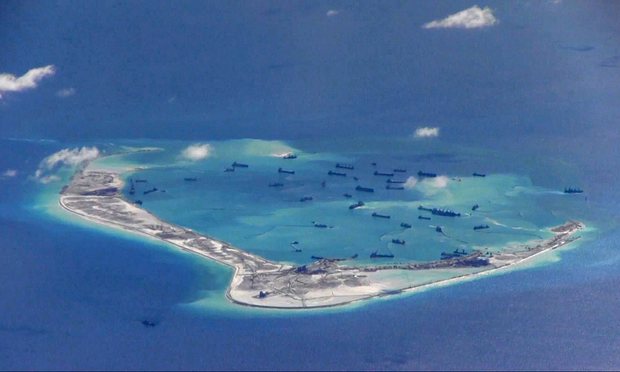
Still image from U.S. Navy video purportedly shows Chinese dredging vessels in the waters around Mischief Reef, which CSIS said will soon have hangar space for 24 fighter-jets plus three to four larger planes. (Handout/Reuters)
Earlier this year, the international community condemned the placement of surface-to-air missiles by Beijing on Woody Island, the site of the largest Chinese presence in the Paracel Island chain. U.S. and Taiwanese officials confirmed the missile defense systems in February, and aerial photos of the missiles taken by AllSource Analysis and Digital Globe were widely circulated by geopolitical think tanks such as Stratfor. Much ado resulted following their discovery, with U.S. Admiral Harry Harris, Commander of the U.S. Pacific Command, stating “I believe China seeks hegemony in East Asia.” Beijing did not deny their presence, instead arguing China was entitled to “limited defensive facilities” on its territory, and subsequently dismissing reports as media hype.
Vietnam is also a claimant to the Paracel Islands, and was not happy with its northern neighbor’s move to further militarize the Paracels. So has Hanoi struck back in similar fashion in the Spratly Islands? A report by Reuters published on August 10 appears to suggest so, as diplomats and military officers told Reuters Hanoi had placed rocket launchers on five bases in the Spratly Islands, pointing them toward Chinese facilities. The rocket launchers are believed to be part of Vietnam’s “Extra” rocket artillery system recently acquired from Israel, with a range of 150km (93 miles) and carry 150kg (330 pounds) warheads that can attack multiple targets simultaneously.
Vietnam, China and Taiwan claim all of the Spratly chain, which comprises some 14 islands, islets and cays and more than 100 reefs, and Brunei, Malaysia and the Philippines claim some of the land features. Vietnam occupies 28 features, comprising 6 islands, Spratly Island, Southwest Cay, Sin Cowe Island, Sand Cay, Namyit Island, Amboyna Cay, along with 16 reefs and 6 banks.
Hanoi has denounced the report as “inaccurate”, while insisting any maritime disputes be resolved by peaceful means and in accordance with international law, including the 1982 United Nations Convention on the Law of the Sea (UNCLOS). Some analysts argue that Hanoi may be reacting to the construction of military hangars on three of the land features (Fiery Cross, Subi and Mischief Reefs) which Beijing occupies, as verified by satellite photographs recently published by the Washington-based Center for Strategic and International Studies (CSIS). CSIS said the land features occupied by China “will soon have hangar space for 24 fighter-jets plus three to four larger planes” and “can easily accommodate any fighter-jet in [China’s] People’s Liberation Army Air Force”.
Unlike the placing of surface-to-air missiles by Beijing on Woody Island back in February, which was substantiated by satellite photography and later confirmed by Beijing, the placement of rocket launchers by Hanoi has neither been confirmed by Hanoi nor photographed—the launchers may have been hidden from aerial surveillance. Nor are the launchers armed, although they could be made operational with rocket artillery rounds within two or three days, according to multiple sources in the story.
While well within Hanoi’s right to defend its territory, the Asia Times argued Vietnam would only place rockets on the Spratly islands as a defensive response. “Even if it had made such a move—or will make any similar attempt in the future—that is mainly a defensive act and a reaction to China’s action in the South China Sea.”
Yet unlike other nations, Hanoi and Beijing have the ability to discuss the South China Sea challenge discreetly, away from the media, with top leaders able to exchange views in a more candid nature, as argued by Harry Kazianis, a Senior Fellow for Defense Policy at The Center for the National Interest.
Of course, any increased militarization of the South China Sea dispute is unwelcome, and taking a knife to a gunfight will not change the balance of power, but Hanoi can hardly be faulted for attempting to defend its position. Yet if the allegation is true, and Hanoi has indeed deployed rocket launchers in the South China Sea, Beijing may choose to retaliate by upping the stakes and countering with more militarization of the seas.
With more guns in the fight, the likelihood of one gun going off under tense circumstances becomes greater. Hopefully, both Communist brothers will sit down away from the media and agree to de-escalate the militarization of the South China Sea, which threatens to spiral out of control soon.